Case Study Analysis: Integrated Nursing Practice in Healthcare
VerifiedAdded on 2022/12/30
|20
|3403
|4
Case Study
AI Summary
This assignment presents four nursing case studies focusing on patients with various conditions, including Parkinson's disease, coronary artery disease, osteoarthritis, multiple sclerosis, and stroke. Each case study includes detailed assessments, diagnoses, and proposed nursing interventions, along with rationales for each intervention. The first case examines a patient with Parkinson's disease, coronary artery disease, and osteoarthritis, addressing motor symptoms, chest pain, and fall risks. The second case focuses on a patient with osteoporosis, incontinence, and cognitive impairment, emphasizing environmental safety and promoting patient orientation. The third case study involves a patient with multiple sclerosis, concentrating on fatigue and impaired urinary elimination. The final case covers a patient with stroke, dysphagia, and hemiparesis, highlighting stroke recovery, fall prevention, and aspiration management. The document provides a comprehensive overview of nursing care planning and clinical decision-making in diverse patient scenarios.
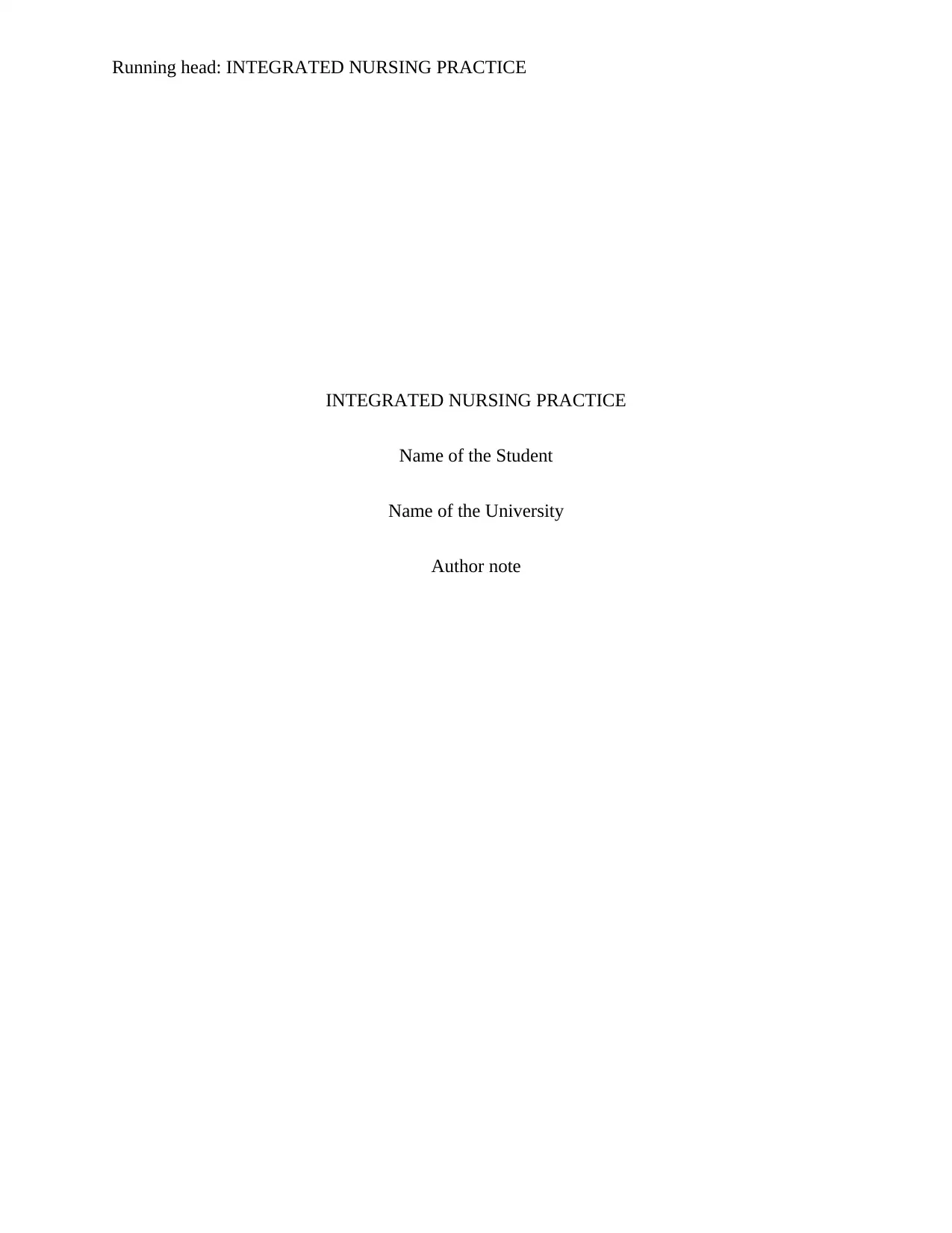
Running head: INTEGRATED NURSING PRACTICE
INTEGRATED NURSING PRACTICE
Name of the Student
Name of the University
Author note
INTEGRATED NURSING PRACTICE
Name of the Student
Name of the University
Author note
Paraphrase This Document
Need a fresh take? Get an instant paraphrase of this document with our AI Paraphraser
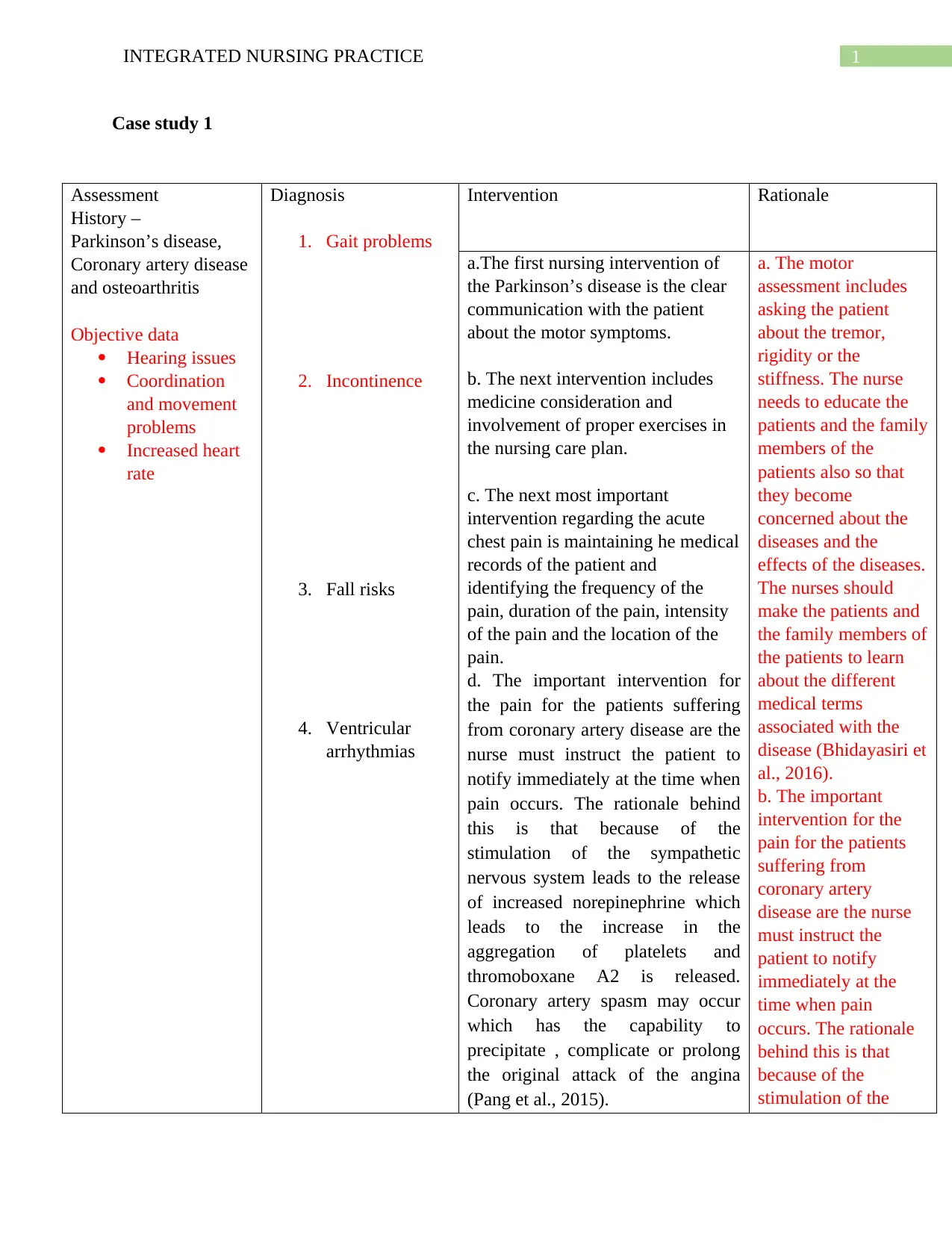
1INTEGRATED NURSING PRACTICE
Case study 1
Assessment
History –
Parkinson’s disease,
Coronary artery disease
and osteoarthritis
Objective data
Hearing issues
Coordination
and movement
problems
Increased heart
rate
Diagnosis
1. Gait problems
2. Incontinence
3. Fall risks
4. Ventricular
arrhythmias
Intervention Rationale
a.The first nursing intervention of
the Parkinson’s disease is the clear
communication with the patient
about the motor symptoms.
b. The next intervention includes
medicine consideration and
involvement of proper exercises in
the nursing care plan.
c. The next most important
intervention regarding the acute
chest pain is maintaining he medical
records of the patient and
identifying the frequency of the
pain, duration of the pain, intensity
of the pain and the location of the
pain.
d. The important intervention for
the pain for the patients suffering
from coronary artery disease are the
nurse must instruct the patient to
notify immediately at the time when
pain occurs. The rationale behind
this is that because of the
stimulation of the sympathetic
nervous system leads to the release
of increased norepinephrine which
leads to the increase in the
aggregation of platelets and
thromoboxane A2 is released.
Coronary artery spasm may occur
which has the capability to
precipitate , complicate or prolong
the original attack of the angina
(Pang et al., 2015).
a. The motor
assessment includes
asking the patient
about the tremor,
rigidity or the
stiffness. The nurse
needs to educate the
patients and the family
members of the
patients also so that
they become
concerned about the
diseases and the
effects of the diseases.
The nurses should
make the patients and
the family members of
the patients to learn
about the different
medical terms
associated with the
disease (Bhidayasiri et
al., 2016).
b. The important
intervention for the
pain for the patients
suffering from
coronary artery
disease are the nurse
must instruct the
patient to notify
immediately at the
time when pain
occurs. The rationale
behind this is that
because of the
stimulation of the
Case study 1
Assessment
History –
Parkinson’s disease,
Coronary artery disease
and osteoarthritis
Objective data
Hearing issues
Coordination
and movement
problems
Increased heart
rate
Diagnosis
1. Gait problems
2. Incontinence
3. Fall risks
4. Ventricular
arrhythmias
Intervention Rationale
a.The first nursing intervention of
the Parkinson’s disease is the clear
communication with the patient
about the motor symptoms.
b. The next intervention includes
medicine consideration and
involvement of proper exercises in
the nursing care plan.
c. The next most important
intervention regarding the acute
chest pain is maintaining he medical
records of the patient and
identifying the frequency of the
pain, duration of the pain, intensity
of the pain and the location of the
pain.
d. The important intervention for
the pain for the patients suffering
from coronary artery disease are the
nurse must instruct the patient to
notify immediately at the time when
pain occurs. The rationale behind
this is that because of the
stimulation of the sympathetic
nervous system leads to the release
of increased norepinephrine which
leads to the increase in the
aggregation of platelets and
thromoboxane A2 is released.
Coronary artery spasm may occur
which has the capability to
precipitate , complicate or prolong
the original attack of the angina
(Pang et al., 2015).
a. The motor
assessment includes
asking the patient
about the tremor,
rigidity or the
stiffness. The nurse
needs to educate the
patients and the family
members of the
patients also so that
they become
concerned about the
diseases and the
effects of the diseases.
The nurses should
make the patients and
the family members of
the patients to learn
about the different
medical terms
associated with the
disease (Bhidayasiri et
al., 2016).
b. The important
intervention for the
pain for the patients
suffering from
coronary artery
disease are the nurse
must instruct the
patient to notify
immediately at the
time when pain
occurs. The rationale
behind this is that
because of the
stimulation of the
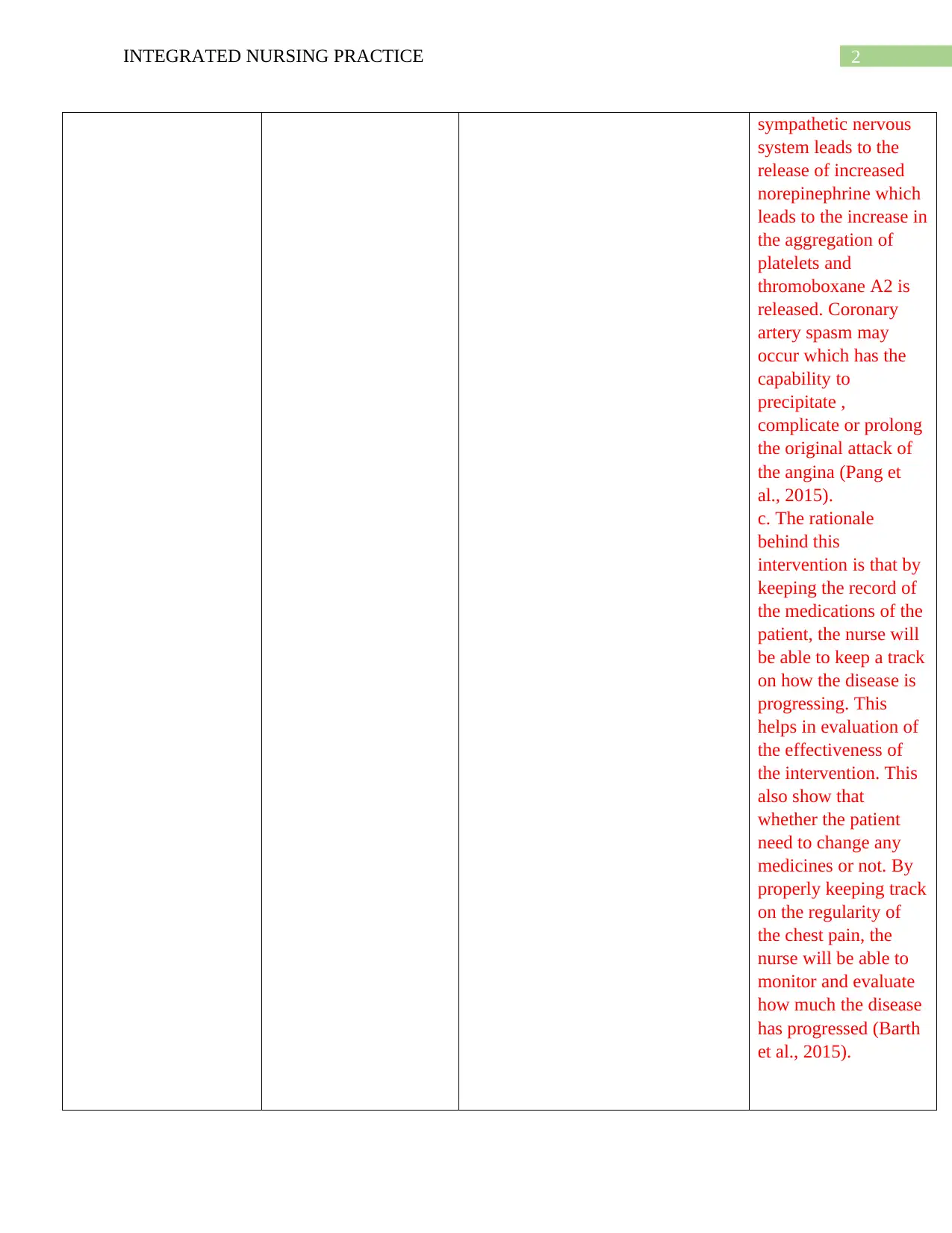
2INTEGRATED NURSING PRACTICE
sympathetic nervous
system leads to the
release of increased
norepinephrine which
leads to the increase in
the aggregation of
platelets and
thromoboxane A2 is
released. Coronary
artery spasm may
occur which has the
capability to
precipitate ,
complicate or prolong
the original attack of
the angina (Pang et
al., 2015).
c. The rationale
behind this
intervention is that by
keeping the record of
the medications of the
patient, the nurse will
be able to keep a track
on how the disease is
progressing. This
helps in evaluation of
the effectiveness of
the intervention. This
also show that
whether the patient
need to change any
medicines or not. By
properly keeping track
on the regularity of
the chest pain, the
nurse will be able to
monitor and evaluate
how much the disease
has progressed (Barth
et al., 2015).
sympathetic nervous
system leads to the
release of increased
norepinephrine which
leads to the increase in
the aggregation of
platelets and
thromoboxane A2 is
released. Coronary
artery spasm may
occur which has the
capability to
precipitate ,
complicate or prolong
the original attack of
the angina (Pang et
al., 2015).
c. The rationale
behind this
intervention is that by
keeping the record of
the medications of the
patient, the nurse will
be able to keep a track
on how the disease is
progressing. This
helps in evaluation of
the effectiveness of
the intervention. This
also show that
whether the patient
need to change any
medicines or not. By
properly keeping track
on the regularity of
the chest pain, the
nurse will be able to
monitor and evaluate
how much the disease
has progressed (Barth
et al., 2015).
⊘ This is a preview!⊘
Do you want full access?
Subscribe today to unlock all pages.

Trusted by 1+ million students worldwide
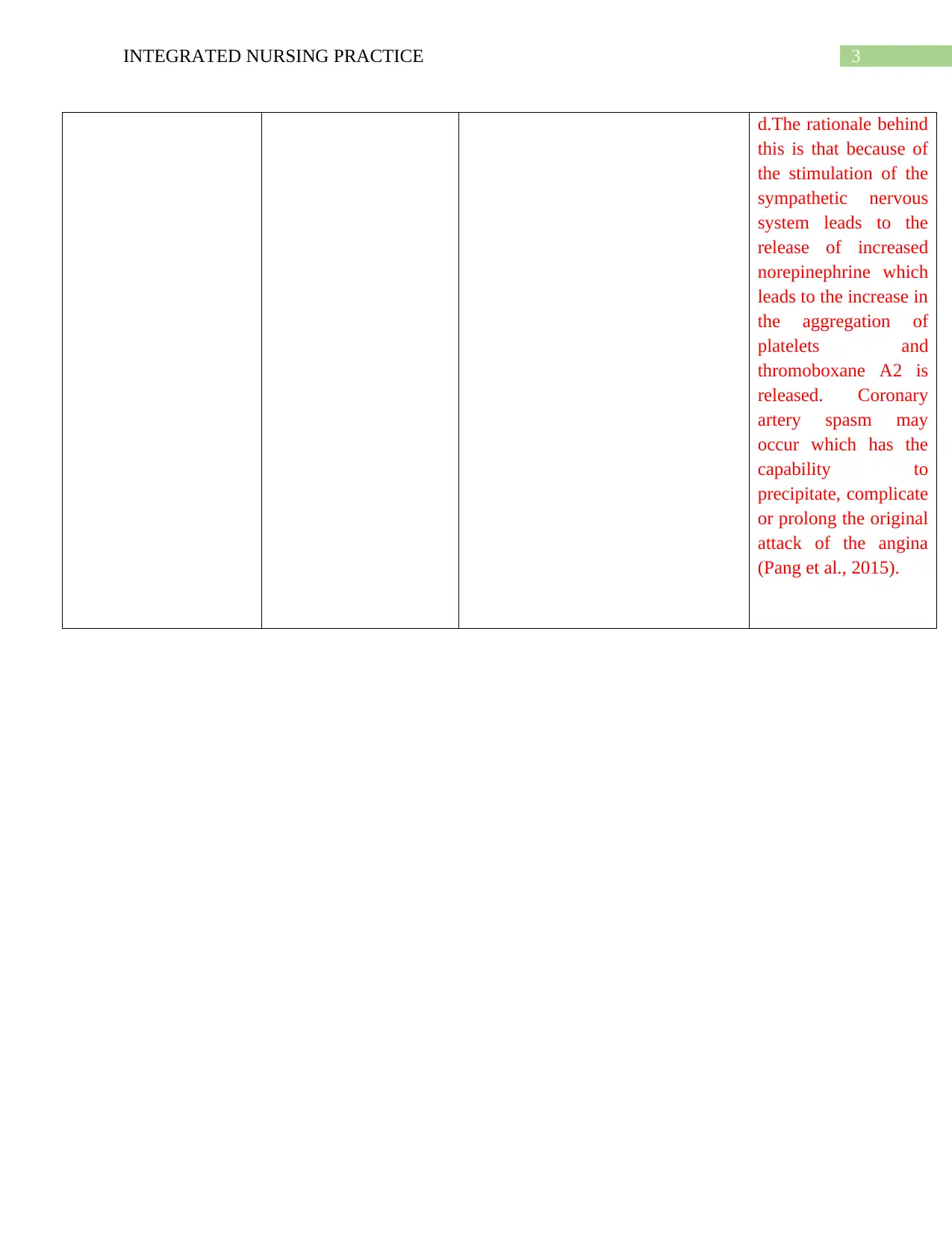
3INTEGRATED NURSING PRACTICE
d.The rationale behind
this is that because of
the stimulation of the
sympathetic nervous
system leads to the
release of increased
norepinephrine which
leads to the increase in
the aggregation of
platelets and
thromoboxane A2 is
released. Coronary
artery spasm may
occur which has the
capability to
precipitate, complicate
or prolong the original
attack of the angina
(Pang et al., 2015).
d.The rationale behind
this is that because of
the stimulation of the
sympathetic nervous
system leads to the
release of increased
norepinephrine which
leads to the increase in
the aggregation of
platelets and
thromoboxane A2 is
released. Coronary
artery spasm may
occur which has the
capability to
precipitate, complicate
or prolong the original
attack of the angina
(Pang et al., 2015).
Paraphrase This Document
Need a fresh take? Get an instant paraphrase of this document with our AI Paraphraser
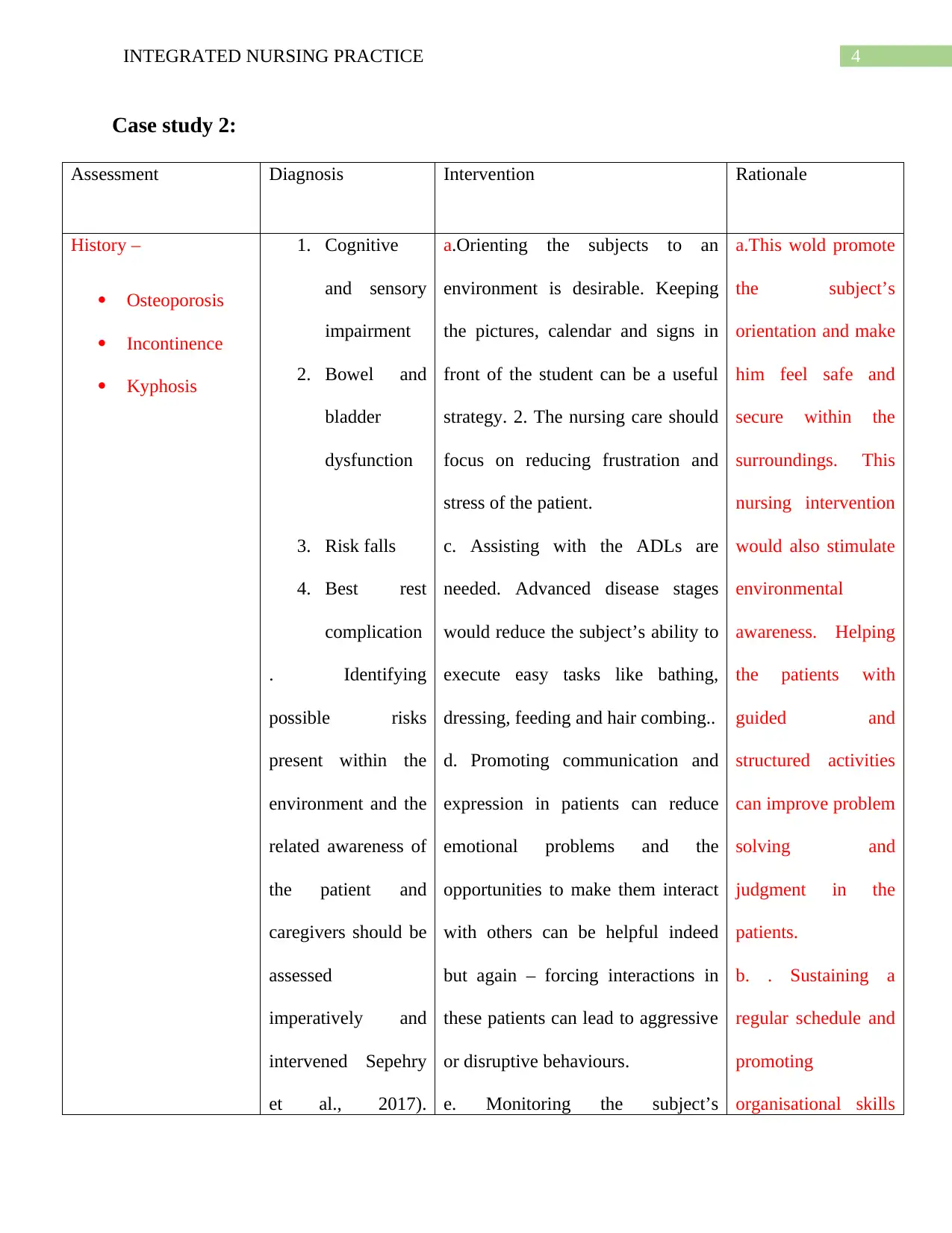
4INTEGRATED NURSING PRACTICE
Case study 2:
Assessment Diagnosis Intervention Rationale
History –
Osteoporosis
Incontinence
Kyphosis
1. Cognitive
and sensory
impairment
2. Bowel and
bladder
dysfunction
3. Risk falls
4. Best rest
complication
. Identifying
possible risks
present within the
environment and the
related awareness of
the patient and
caregivers should be
assessed
imperatively and
intervened Sepehry
et al., 2017).
a.Orienting the subjects to an
environment is desirable. Keeping
the pictures, calendar and signs in
front of the student can be a useful
strategy. 2. The nursing care should
focus on reducing frustration and
stress of the patient.
c. Assisting with the ADLs are
needed. Advanced disease stages
would reduce the subject’s ability to
execute easy tasks like bathing,
dressing, feeding and hair combing..
d. Promoting communication and
expression in patients can reduce
emotional problems and the
opportunities to make them interact
with others can be helpful indeed
but again – forcing interactions in
these patients can lead to aggressive
or disruptive behaviours.
e. Monitoring the subject’s
a.This wold promote
the subject’s
orientation and make
him feel safe and
secure within the
surroundings. This
nursing intervention
would also stimulate
environmental
awareness. Helping
the patients with
guided and
structured activities
can improve problem
solving and
judgment in the
patients.
b. . Sustaining a
regular schedule and
promoting
organisational skills
Case study 2:
Assessment Diagnosis Intervention Rationale
History –
Osteoporosis
Incontinence
Kyphosis
1. Cognitive
and sensory
impairment
2. Bowel and
bladder
dysfunction
3. Risk falls
4. Best rest
complication
. Identifying
possible risks
present within the
environment and the
related awareness of
the patient and
caregivers should be
assessed
imperatively and
intervened Sepehry
et al., 2017).
a.Orienting the subjects to an
environment is desirable. Keeping
the pictures, calendar and signs in
front of the student can be a useful
strategy. 2. The nursing care should
focus on reducing frustration and
stress of the patient.
c. Assisting with the ADLs are
needed. Advanced disease stages
would reduce the subject’s ability to
execute easy tasks like bathing,
dressing, feeding and hair combing..
d. Promoting communication and
expression in patients can reduce
emotional problems and the
opportunities to make them interact
with others can be helpful indeed
but again – forcing interactions in
these patients can lead to aggressive
or disruptive behaviours.
e. Monitoring the subject’s
a.This wold promote
the subject’s
orientation and make
him feel safe and
secure within the
surroundings. This
nursing intervention
would also stimulate
environmental
awareness. Helping
the patients with
guided and
structured activities
can improve problem
solving and
judgment in the
patients.
b. . Sustaining a
regular schedule and
promoting
organisational skills
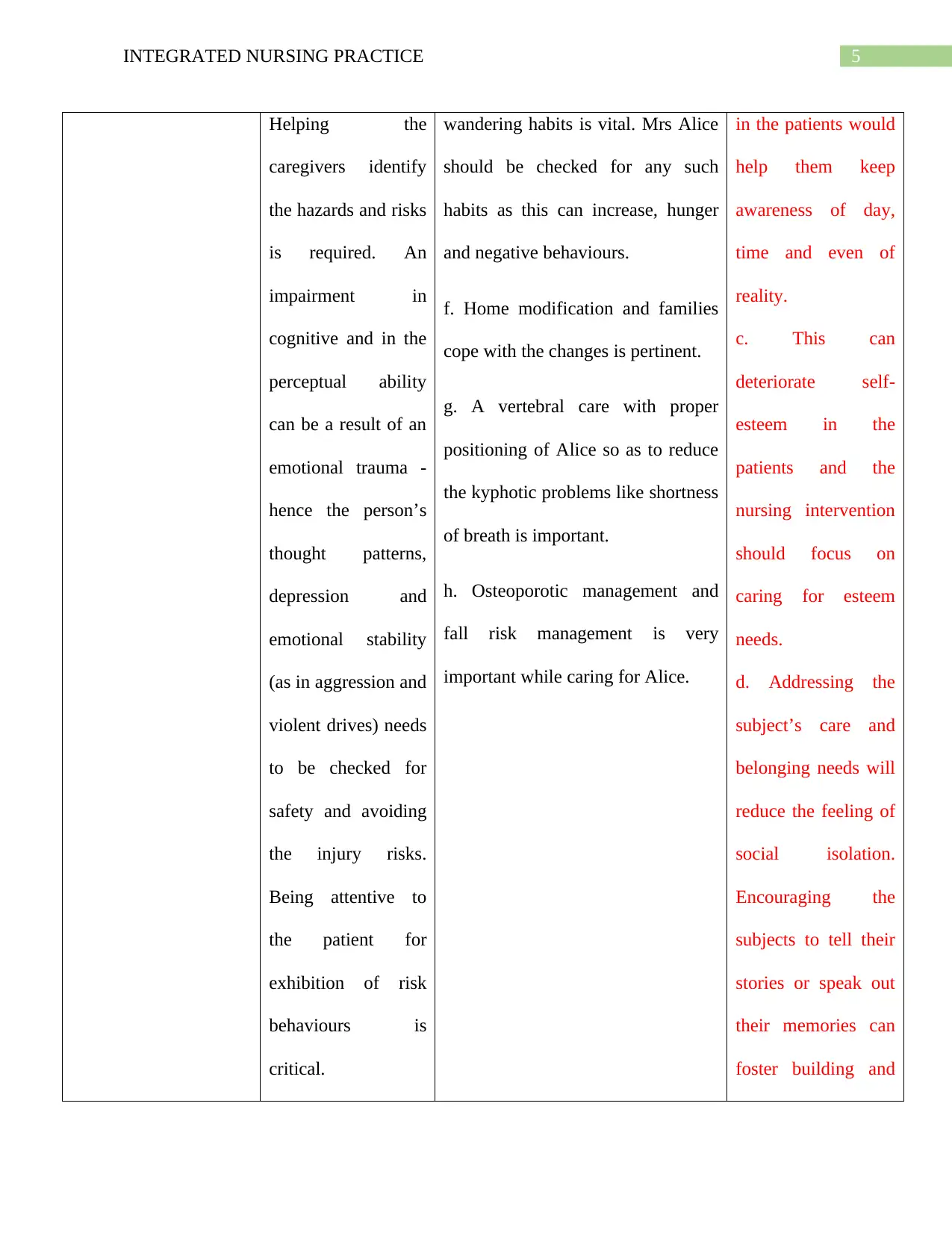
5INTEGRATED NURSING PRACTICE
Helping the
caregivers identify
the hazards and risks
is required. An
impairment in
cognitive and in the
perceptual ability
can be a result of an
emotional trauma -
hence the person’s
thought patterns,
depression and
emotional stability
(as in aggression and
violent drives) needs
to be checked for
safety and avoiding
the injury risks.
Being attentive to
the patient for
exhibition of risk
behaviours is
critical.
wandering habits is vital. Mrs Alice
should be checked for any such
habits as this can increase, hunger
and negative behaviours.
f. Home modification and families
cope with the changes is pertinent.
g. A vertebral care with proper
positioning of Alice so as to reduce
the kyphotic problems like shortness
of breath is important.
h. Osteoporotic management and
fall risk management is very
important while caring for Alice.
in the patients would
help them keep
awareness of day,
time and even of
reality.
c. This can
deteriorate self-
esteem in the
patients and the
nursing intervention
should focus on
caring for esteem
needs.
d. Addressing the
subject’s care and
belonging needs will
reduce the feeling of
social isolation.
Encouraging the
subjects to tell their
stories or speak out
their memories can
foster building and
Helping the
caregivers identify
the hazards and risks
is required. An
impairment in
cognitive and in the
perceptual ability
can be a result of an
emotional trauma -
hence the person’s
thought patterns,
depression and
emotional stability
(as in aggression and
violent drives) needs
to be checked for
safety and avoiding
the injury risks.
Being attentive to
the patient for
exhibition of risk
behaviours is
critical.
wandering habits is vital. Mrs Alice
should be checked for any such
habits as this can increase, hunger
and negative behaviours.
f. Home modification and families
cope with the changes is pertinent.
g. A vertebral care with proper
positioning of Alice so as to reduce
the kyphotic problems like shortness
of breath is important.
h. Osteoporotic management and
fall risk management is very
important while caring for Alice.
in the patients would
help them keep
awareness of day,
time and even of
reality.
c. This can
deteriorate self-
esteem in the
patients and the
nursing intervention
should focus on
caring for esteem
needs.
d. Addressing the
subject’s care and
belonging needs will
reduce the feeling of
social isolation.
Encouraging the
subjects to tell their
stories or speak out
their memories can
foster building and
⊘ This is a preview!⊘
Do you want full access?
Subscribe today to unlock all pages.

Trusted by 1+ million students worldwide
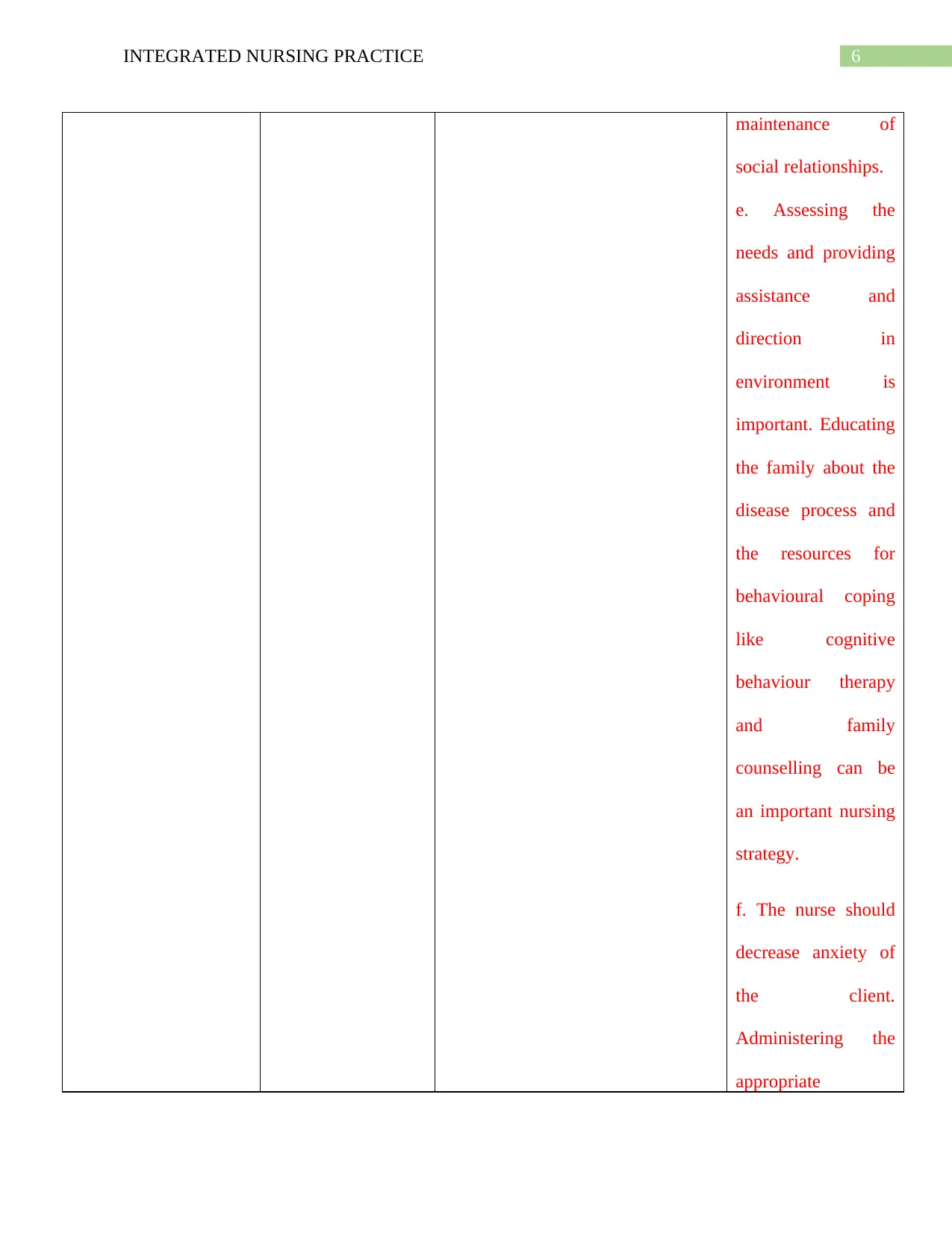
6INTEGRATED NURSING PRACTICE
maintenance of
social relationships.
e. Assessing the
needs and providing
assistance and
direction in
environment is
important. Educating
the family about the
disease process and
the resources for
behavioural coping
like cognitive
behaviour therapy
and family
counselling can be
an important nursing
strategy.
f. The nurse should
decrease anxiety of
the client.
Administering the
appropriate
maintenance of
social relationships.
e. Assessing the
needs and providing
assistance and
direction in
environment is
important. Educating
the family about the
disease process and
the resources for
behavioural coping
like cognitive
behaviour therapy
and family
counselling can be
an important nursing
strategy.
f. The nurse should
decrease anxiety of
the client.
Administering the
appropriate
Paraphrase This Document
Need a fresh take? Get an instant paraphrase of this document with our AI Paraphraser
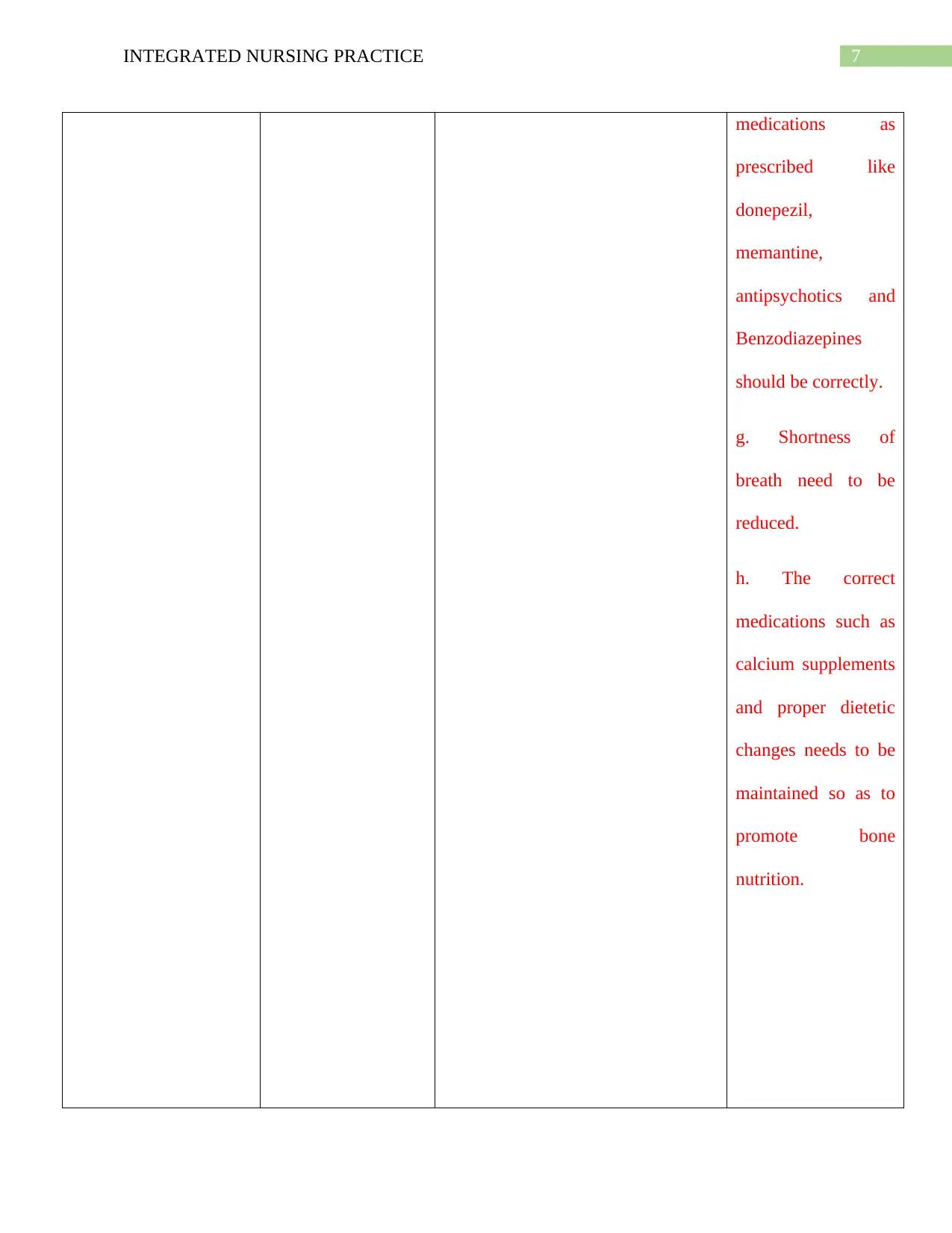
7INTEGRATED NURSING PRACTICE
medications as
prescribed like
donepezil,
memantine,
antipsychotics and
Benzodiazepines
should be correctly.
g. Shortness of
breath need to be
reduced.
h. The correct
medications such as
calcium supplements
and proper dietetic
changes needs to be
maintained so as to
promote bone
nutrition.
medications as
prescribed like
donepezil,
memantine,
antipsychotics and
Benzodiazepines
should be correctly.
g. Shortness of
breath need to be
reduced.
h. The correct
medications such as
calcium supplements
and proper dietetic
changes needs to be
maintained so as to
promote bone
nutrition.
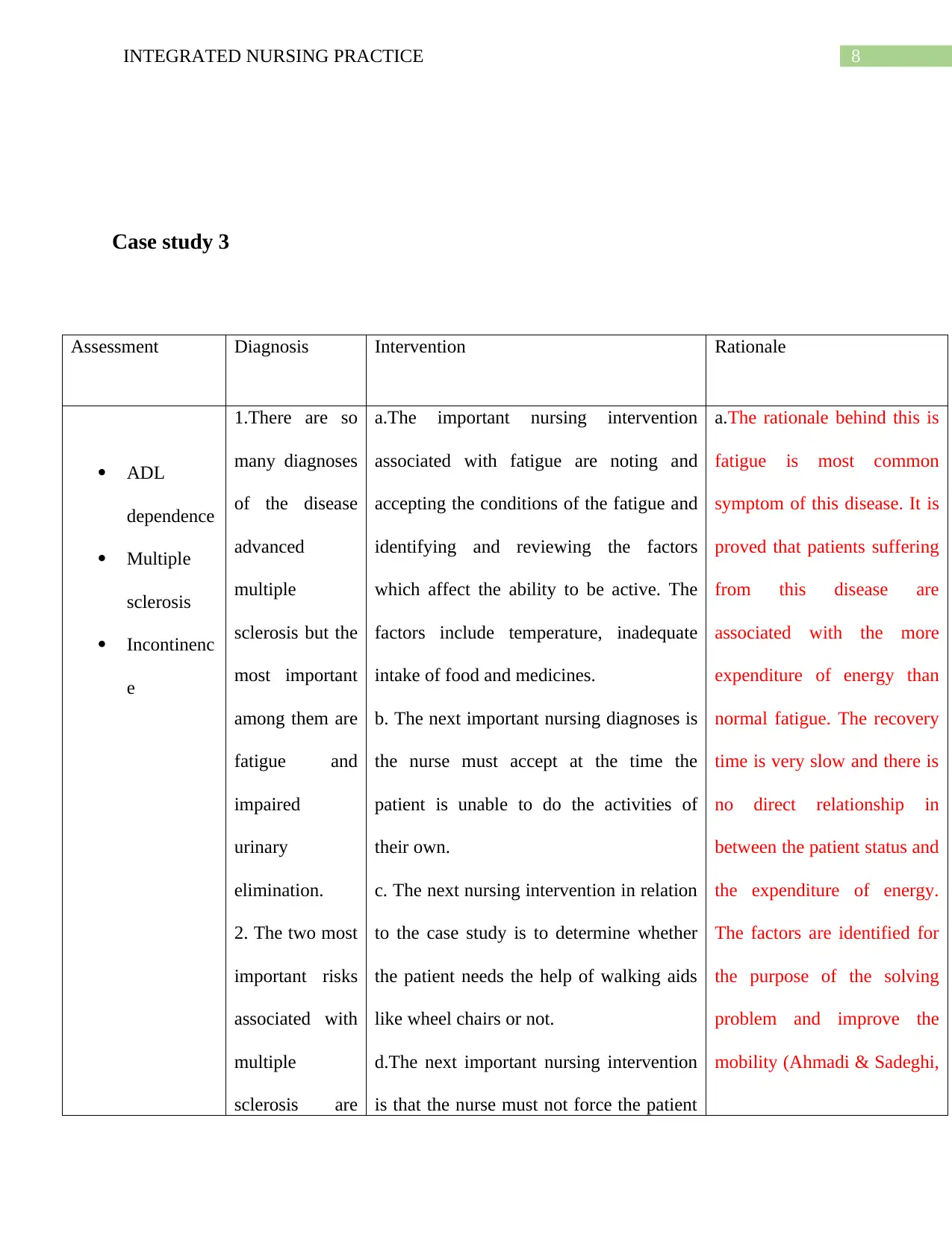
8INTEGRATED NURSING PRACTICE
Case study 3
Assessment Diagnosis Intervention Rationale
ADL
dependence
Multiple
sclerosis
Incontinenc
e
1.There are so
many diagnoses
of the disease
advanced
multiple
sclerosis but the
most important
among them are
fatigue and
impaired
urinary
elimination.
2. The two most
important risks
associated with
multiple
sclerosis are
a.The important nursing intervention
associated with fatigue are noting and
accepting the conditions of the fatigue and
identifying and reviewing the factors
which affect the ability to be active. The
factors include temperature, inadequate
intake of food and medicines.
b. The next important nursing diagnoses is
the nurse must accept at the time the
patient is unable to do the activities of
their own.
c. The next nursing intervention in relation
to the case study is to determine whether
the patient needs the help of walking aids
like wheel chairs or not.
d.The next important nursing intervention
is that the nurse must not force the patient
a.The rationale behind this is
fatigue is most common
symptom of this disease. It is
proved that patients suffering
from this disease are
associated with the more
expenditure of energy than
normal fatigue. The recovery
time is very slow and there is
no direct relationship in
between the patient status and
the expenditure of energy.
The factors are identified for
the purpose of the solving
problem and improve the
mobility (Ahmadi & Sadeghi,
Case study 3
Assessment Diagnosis Intervention Rationale
ADL
dependence
Multiple
sclerosis
Incontinenc
e
1.There are so
many diagnoses
of the disease
advanced
multiple
sclerosis but the
most important
among them are
fatigue and
impaired
urinary
elimination.
2. The two most
important risks
associated with
multiple
sclerosis are
a.The important nursing intervention
associated with fatigue are noting and
accepting the conditions of the fatigue and
identifying and reviewing the factors
which affect the ability to be active. The
factors include temperature, inadequate
intake of food and medicines.
b. The next important nursing diagnoses is
the nurse must accept at the time the
patient is unable to do the activities of
their own.
c. The next nursing intervention in relation
to the case study is to determine whether
the patient needs the help of walking aids
like wheel chairs or not.
d.The next important nursing intervention
is that the nurse must not force the patient
a.The rationale behind this is
fatigue is most common
symptom of this disease. It is
proved that patients suffering
from this disease are
associated with the more
expenditure of energy than
normal fatigue. The recovery
time is very slow and there is
no direct relationship in
between the patient status and
the expenditure of energy.
The factors are identified for
the purpose of the solving
problem and improve the
mobility (Ahmadi & Sadeghi,
⊘ This is a preview!⊘
Do you want full access?
Subscribe today to unlock all pages.

Trusted by 1+ million students worldwide
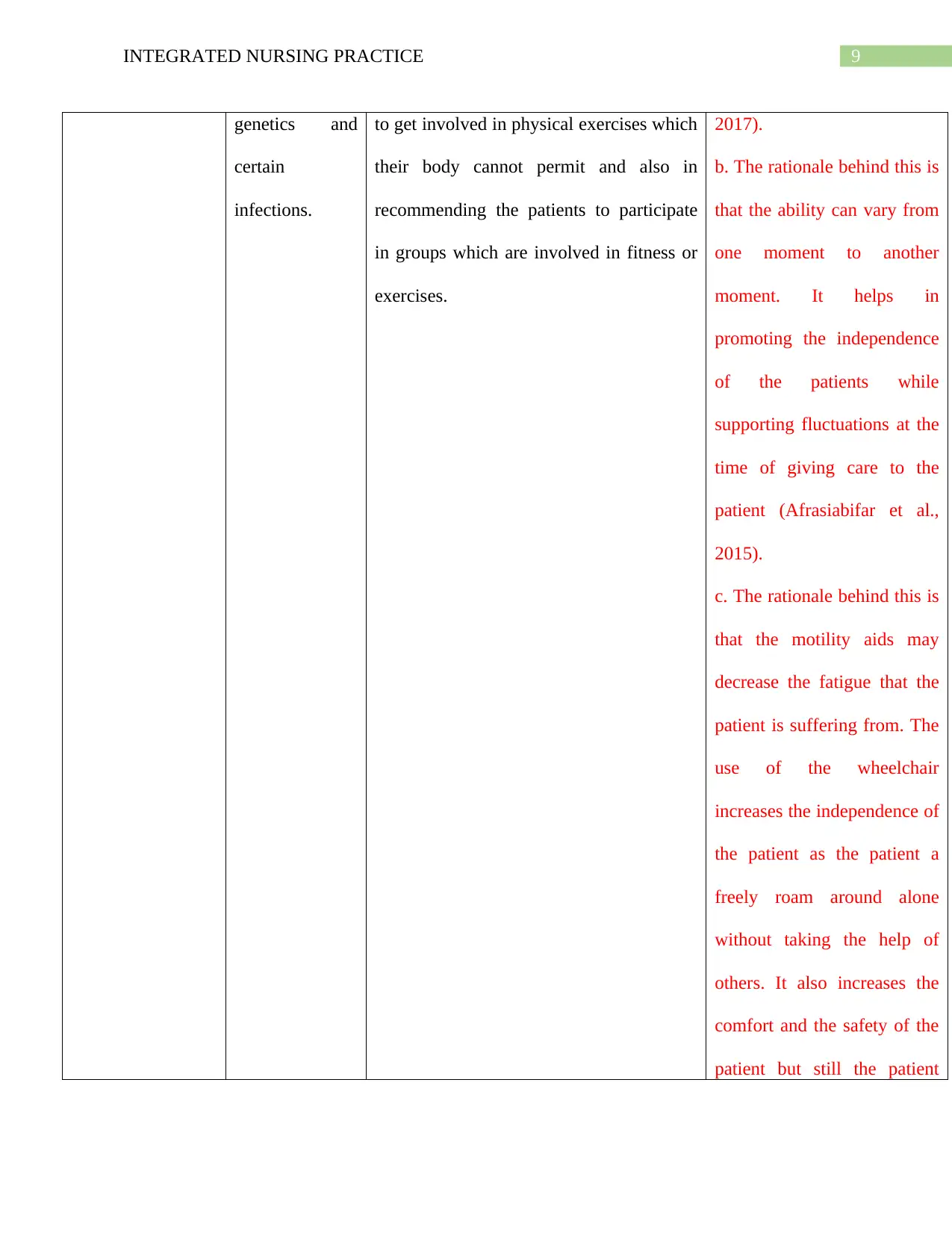
9INTEGRATED NURSING PRACTICE
genetics and
certain
infections.
to get involved in physical exercises which
their body cannot permit and also in
recommending the patients to participate
in groups which are involved in fitness or
exercises.
2017).
b. The rationale behind this is
that the ability can vary from
one moment to another
moment. It helps in
promoting the independence
of the patients while
supporting fluctuations at the
time of giving care to the
patient (Afrasiabifar et al.,
2015).
c. The rationale behind this is
that the motility aids may
decrease the fatigue that the
patient is suffering from. The
use of the wheelchair
increases the independence of
the patient as the patient a
freely roam around alone
without taking the help of
others. It also increases the
comfort and the safety of the
patient but still the patient
genetics and
certain
infections.
to get involved in physical exercises which
their body cannot permit and also in
recommending the patients to participate
in groups which are involved in fitness or
exercises.
2017).
b. The rationale behind this is
that the ability can vary from
one moment to another
moment. It helps in
promoting the independence
of the patients while
supporting fluctuations at the
time of giving care to the
patient (Afrasiabifar et al.,
2015).
c. The rationale behind this is
that the motility aids may
decrease the fatigue that the
patient is suffering from. The
use of the wheelchair
increases the independence of
the patient as the patient a
freely roam around alone
without taking the help of
others. It also increases the
comfort and the safety of the
patient but still the patient
Paraphrase This Document
Need a fresh take? Get an instant paraphrase of this document with our AI Paraphraser
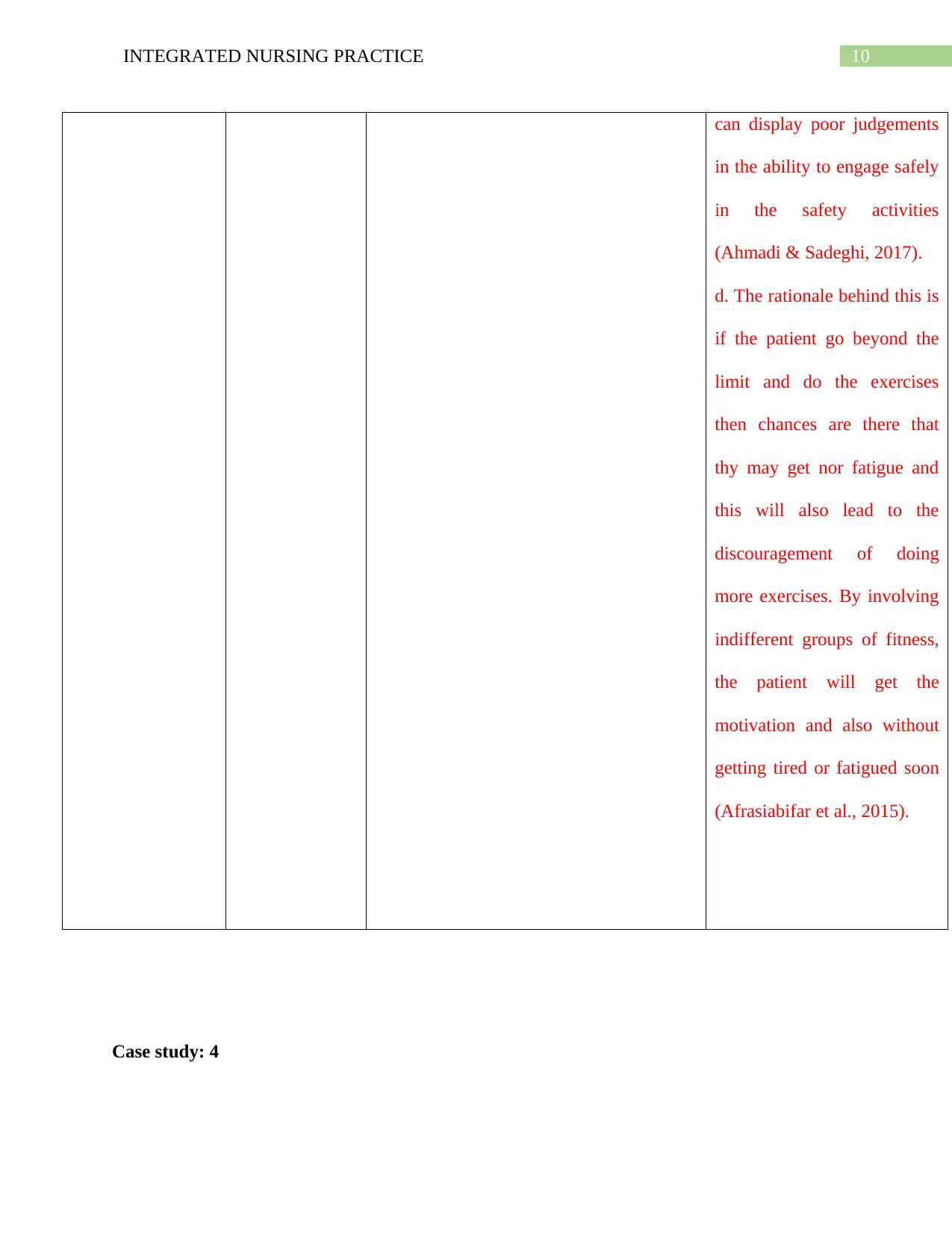
10INTEGRATED NURSING PRACTICE
can display poor judgements
in the ability to engage safely
in the safety activities
(Ahmadi & Sadeghi, 2017).
d. The rationale behind this is
if the patient go beyond the
limit and do the exercises
then chances are there that
thy may get nor fatigue and
this will also lead to the
discouragement of doing
more exercises. By involving
indifferent groups of fitness,
the patient will get the
motivation and also without
getting tired or fatigued soon
(Afrasiabifar et al., 2015).
Case study: 4
can display poor judgements
in the ability to engage safely
in the safety activities
(Ahmadi & Sadeghi, 2017).
d. The rationale behind this is
if the patient go beyond the
limit and do the exercises
then chances are there that
thy may get nor fatigue and
this will also lead to the
discouragement of doing
more exercises. By involving
indifferent groups of fitness,
the patient will get the
motivation and also without
getting tired or fatigued soon
(Afrasiabifar et al., 2015).
Case study: 4
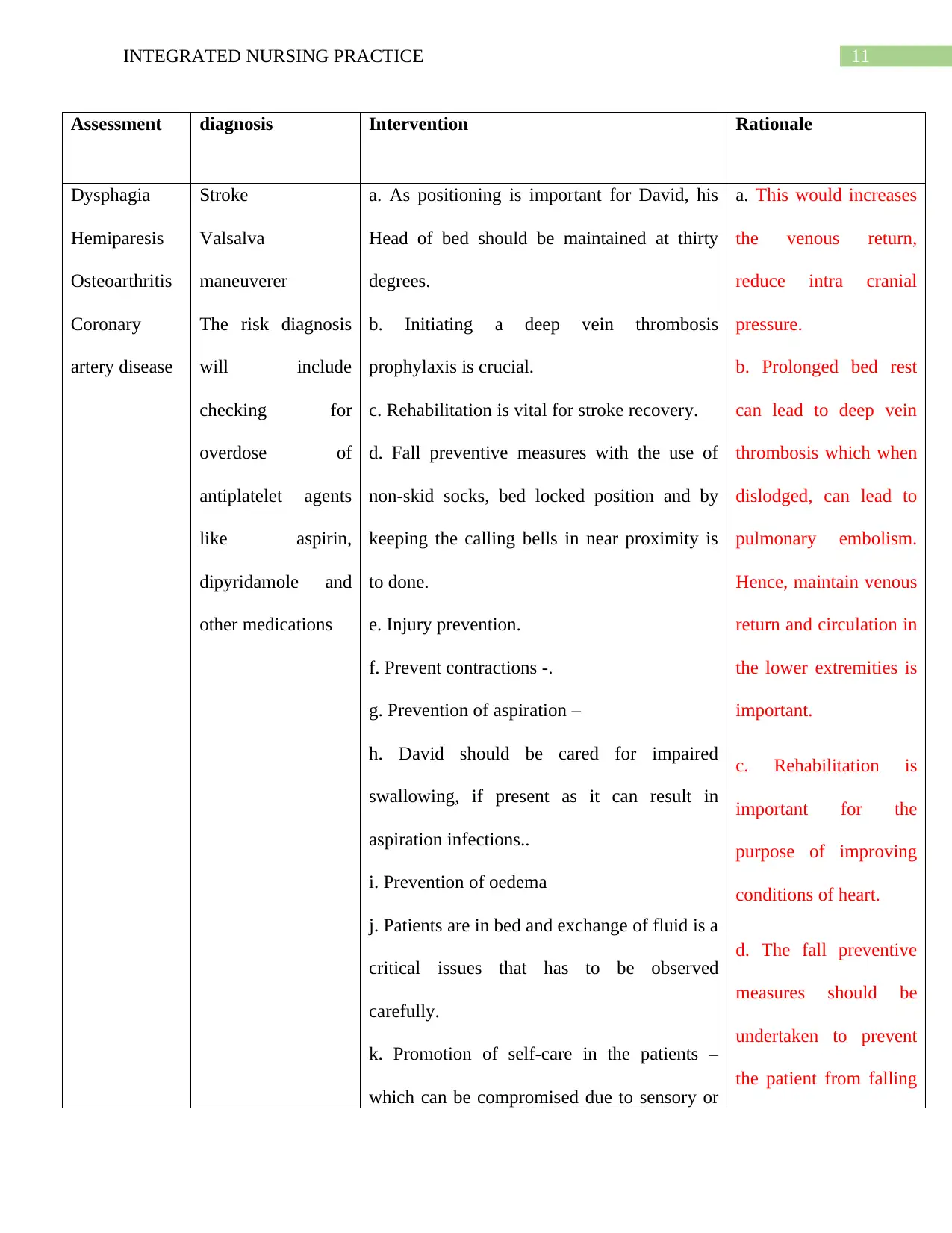
11INTEGRATED NURSING PRACTICE
Assessment diagnosis Intervention Rationale
Dysphagia
Hemiparesis
Osteoarthritis
Coronary
artery disease
Stroke
Valsalva
maneuverer
The risk diagnosis
will include
checking for
overdose of
antiplatelet agents
like aspirin,
dipyridamole and
other medications
a. As positioning is important for David, his
Head of bed should be maintained at thirty
degrees.
b. Initiating a deep vein thrombosis
prophylaxis is crucial.
c. Rehabilitation is vital for stroke recovery.
d. Fall preventive measures with the use of
non-skid socks, bed locked position and by
keeping the calling bells in near proximity is
to done.
e. Injury prevention.
f. Prevent contractions -.
g. Prevention of aspiration –
h. David should be cared for impaired
swallowing, if present as it can result in
aspiration infections..
i. Prevention of oedema
j. Patients are in bed and exchange of fluid is a
critical issues that has to be observed
carefully.
k. Promotion of self-care in the patients –
which can be compromised due to sensory or
a. This would increases
the venous return,
reduce intra cranial
pressure.
b. Prolonged bed rest
can lead to deep vein
thrombosis which when
dislodged, can lead to
pulmonary embolism.
Hence, maintain venous
return and circulation in
the lower extremities is
important.
c. Rehabilitation is
important for the
purpose of improving
conditions of heart.
d. The fall preventive
measures should be
undertaken to prevent
the patient from falling
Assessment diagnosis Intervention Rationale
Dysphagia
Hemiparesis
Osteoarthritis
Coronary
artery disease
Stroke
Valsalva
maneuverer
The risk diagnosis
will include
checking for
overdose of
antiplatelet agents
like aspirin,
dipyridamole and
other medications
a. As positioning is important for David, his
Head of bed should be maintained at thirty
degrees.
b. Initiating a deep vein thrombosis
prophylaxis is crucial.
c. Rehabilitation is vital for stroke recovery.
d. Fall preventive measures with the use of
non-skid socks, bed locked position and by
keeping the calling bells in near proximity is
to done.
e. Injury prevention.
f. Prevent contractions -.
g. Prevention of aspiration –
h. David should be cared for impaired
swallowing, if present as it can result in
aspiration infections..
i. Prevention of oedema
j. Patients are in bed and exchange of fluid is a
critical issues that has to be observed
carefully.
k. Promotion of self-care in the patients –
which can be compromised due to sensory or
a. This would increases
the venous return,
reduce intra cranial
pressure.
b. Prolonged bed rest
can lead to deep vein
thrombosis which when
dislodged, can lead to
pulmonary embolism.
Hence, maintain venous
return and circulation in
the lower extremities is
important.
c. Rehabilitation is
important for the
purpose of improving
conditions of heart.
d. The fall preventive
measures should be
undertaken to prevent
the patient from falling
⊘ This is a preview!⊘
Do you want full access?
Subscribe today to unlock all pages.

Trusted by 1+ million students worldwide
1 out of 20
Your All-in-One AI-Powered Toolkit for Academic Success.
+13062052269
info@desklib.com
Available 24*7 on WhatsApp / Email
![[object Object]](/_next/static/media/star-bottom.7253800d.svg)
Unlock your academic potential
Copyright © 2020–2025 A2Z Services. All Rights Reserved. Developed and managed by ZUCOL.


